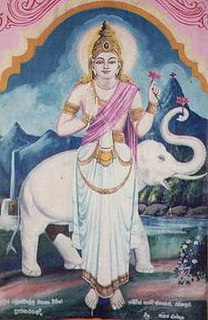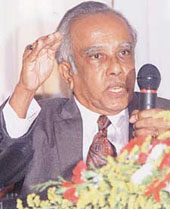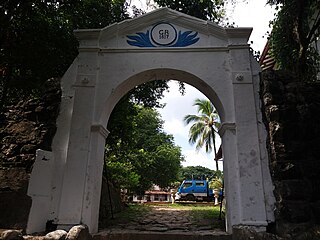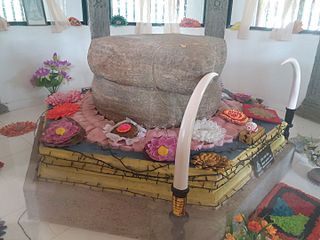
Ratnapura is a major city in Sri Lanka. It is the capital city of Sabaragamuwa Province, as well as the Ratnapura District, and is a traditional centre for the Sri Lankan gem trade. It is located on the Kalu Ganga in south-central Sri Lanka, some 101 km (63 mi) southeast of the country's capital, Colombo. Ratnapura is also spelled as Rathnapura.

Matara is a major city in Sri Lanka, on the southern coast of Southern Province, 160 km from Colombo. It is a major commercial hub, and it is the administrative capital of Matara District. It was gravely affected by the Asian tsunami in December 2004.

Negombo is a major city in Sri Lanka, situated on the west coast and at the mouth of the Negombo Lagoon, in Western Province.

Saman is a deity, subject to local and indigenous belief and worship in Sri Lanka. The name Saman means "the rising morning sun". His character is of historical significance for the Sinhalese people and veneration especially to all the Buddhists. God Maha Sumana Saman is depicted crowned, bejeweled, holding a lotus flower in his right or left hand and accompanied by a white elephant.

Forts and fortifications in Sri Lanka date back thousands of years with many being built by Sri Lankan Kings, these include several walled cities. With the out set of colonial rule in the Indian Ocean, Sri Lanka was occupied by several major colonial empires that from time-to-time became the dominant power in the Indian Ocean. The colonists built several western styled forts, mostly in and round the cost of the island. The first to build colonial forts in Sri Lanka were the Portuguese, these forts were captured and later expanded by the Dutch. The British occupied these Dutch forts during the Napoleonic wars.

Mayadunne (1501–1581) was a king of the Kingdom of Sitawaka, who ruled for 60 years between 1521 and 1581. Mayadunne was a fierce opponent of the Portuguese, who had arrived on the Island in 1505. He devoted his whole life attempting to oust his brother Bhuvanekabahu, the king of Kotte and thereby preserve the independence of Lanka, which was being undermined by the Portuguese intrigue. He constantly invaded the territory of Bhuvanekabahu of Kotte.

Kataragama deviyo is a guardian deity of Sri Lanka. A popular deity who is considered to be very powerful, shrines dedicated to Kataragama deviyo are found in many places of the country. Sinhalese Buddhists believe him also as a divine patron of the Buddha Sasana in Sri Lanka. An ancient temple dedicated to God Kataragama, known as Ruhunu Maha Kataragama Devalaya is situated in the South-Eastern town of Kataragama in Monaragala District of Uva Province.

Upulvan is a guardian deity of Sri Lanka. Sri Lankan Buddhists believe him also as a protector of the Buddhism in the country. The name Upulvan depicts his body colour which means "blue water lily coloured". The cult of Upulvan started during the medieval period in Sri Lanka and later the deity was identified with the god Vishnu of the Hindu tradition. According to the local lore and legend, Upulvan is the god whom the Lord Buddha entrusted with the guardianship of Sri Lanka and Buddha Śāsana of the country.

Kastane is a short traditional ceremonial/decorative single-edged sword of Sri Lanka. Kastanes often have elaborate hilts, especially shaped and described as a rich mythical style inherited from Buddhism in blending a variety of Icons including, Lions, Kirtimukha Serapendiya, Nagas, crocodile/human monsters and other dragon and gargoyle like effigies. Some appear seemingly emitted onto the hand guard and cross guard with Vajra style pseudo-quillons whose finials are also decorated by minor monsters and a rain-guard decorated by the Makara or Serapendiya peacock tail or fish scales which occasionally flows over and onto the blade at the throat. The scabbard is occasionally seen with a miniature beasts head at the chape also emitting an icon or cloud pattern. Sometimes a small human face decorates the hand-guard which is a half human/half crocodile monster.

Clifford Senaka Ratwatte was a Sri Lankan politician. He was a former Parliamentary Secretary to the Minister of Agriculture, Food, Co-operatives and Fisheries in 1964 Member of Parliament for Balangoda, Chairman of the State Plantations Corporation and the Sri Lanka Tea Board.

Arippu Fort was built by the Portuguese and was handed over to the Dutch in 1658. The small bastion fort is located in Arippu, which is 16 km (9.9 mi) away from Mannar Island. The fort is nearly square in shape, with two bastions.

Ratnapura Dutch fort,, was built by the Dutch in Ratnapura, Sri Lanka.

Maha Saman Devalaya or the Great Saman Temple is a shrine dedicated to deity Saman, situated at Ratnapura, Sri Lanka who is the presiding deity of the Sri Pada Mountain which is also called Samanthakuta meaning the mountain of Saman which is believed to have the left foot impression of Lord Buddha which he kept in his visit to Sri Lanka.

Delgamuwa Raja Maha Vihara is an ancient Buddhist temple situated in Kuruvita of Ratnapura District, Sri Lanka. This temple is reputed as the hiding place of the tooth relic of Buddha during the ruling period of Portuguese in the country.

The Department of Archaeology, declared the Nawagamuwa Pattini Devalaya as an Archaeological Protected Monuments in Colombo District for its importance in historical, architectural and anthropological facets. According to popular legends the early establishment of Devalaya goes back to 1st century AD. Nawagamuwa also inherits archeological sites that dates back to BC period as per archaeological research conducted in the area. The Devalaya is popular among the masses for its miracles and to receive the blessings of the goddess Pattini.

Alawathugoda Saman Devalaya is an ancient Devalaya, situated in Alawatugoda, Sri Lanka. The shrine is dedicated to Sinhalese deity Saman and is considered as the 3rd most important Saman Devalaya in the country. The history of the Devalaya is believed to be dated back to the reign of King Walagamba of Anuradhapura Kingdom. During the Portuguese era the shrine was burnt down by the Portuguese armies but rebuilt again in 1814. Currently the shrine has been formally recognized by the government as an archaeological protected monument. The designation was declared on 8 April 2009 under the government Gazette number 1597.

Sri Subodharama Raja Maha Vihara is a historic Buddhist temple situated at Dehiwala in the Western province, Sri Lanka. The temple is located at the Dehiwala junction on the Colombo-Galle main road, about 9 miles south of Colombo city. The temple has been formally recognised by the Government as an archaeological site in Sri Lanka. The designation was declared on 23 February 2007 under the government Gazette number 1486.

Kotte Raja Maha Vihara is a historic Buddhist temple situated in Sri Jayawardenepura Kotte, Western province, Sri Lanka. It is located near to the historic building Pita Kotte Gal Ambalama at the Pita Kotte junction on Kotte road. The temple has been formally recognised by the Government as an archaeological site in Sri Lanka. The designation was declared on 17 May 2013 under the government Gazette number 1811.

Uggal Aluthnuwara Kataragama Devalaya is an ancient devalaya, situated in Uggal Aluthnuwara, Sri Lanka. It lies on Colombo - Batticaloa main road, approximately 9 km (5.6 mi) away from the Balangoda town. The shrine is dedicated to the Sinhalese deity Kataragama deviyo, who is believed as a guardian deity of the Buddha Sasana in Sri Lanka. The devalaya has been formally recognised by the government as an archaeological protected monument. The designation was declared on 3 September 1999 under the government Gazette number 1096.























